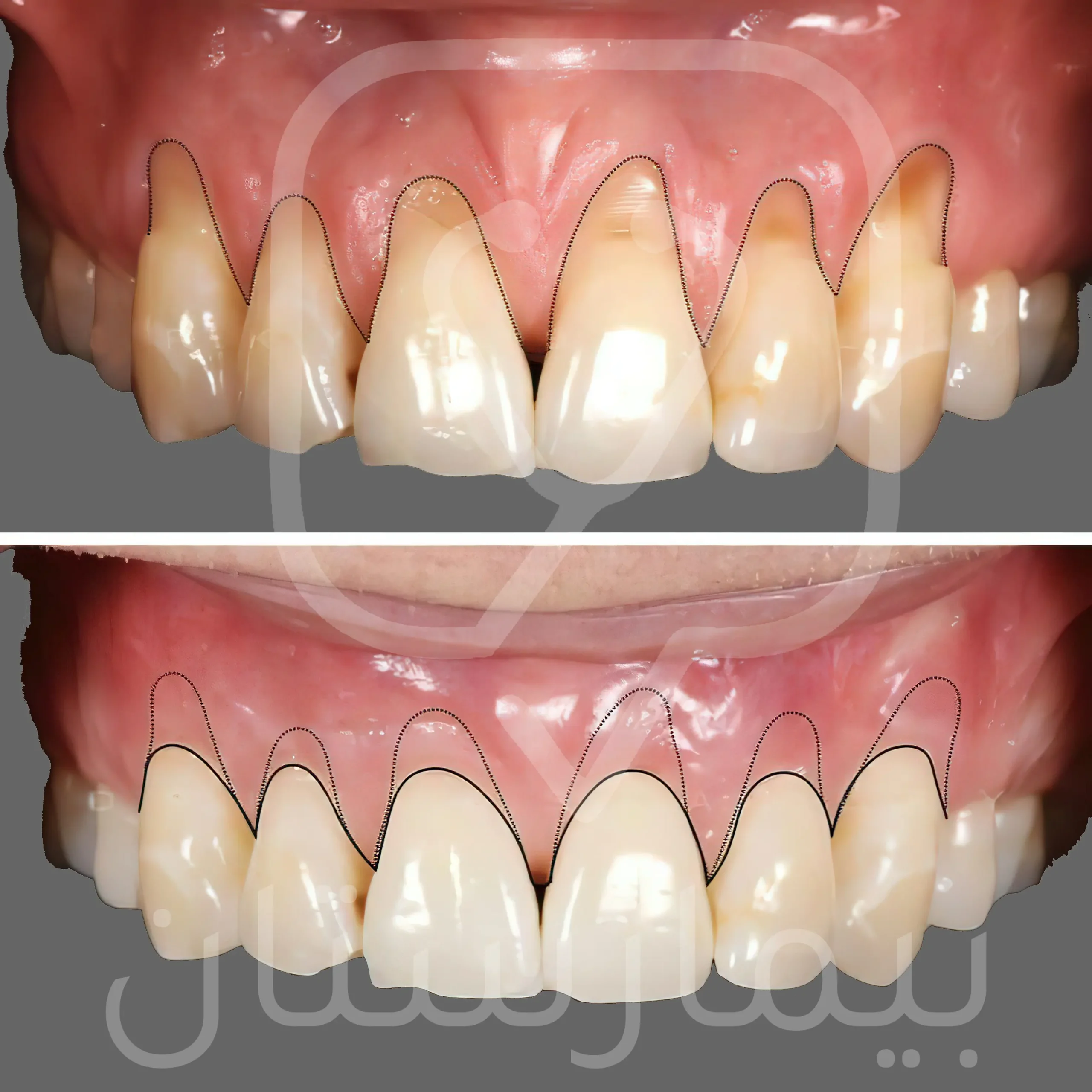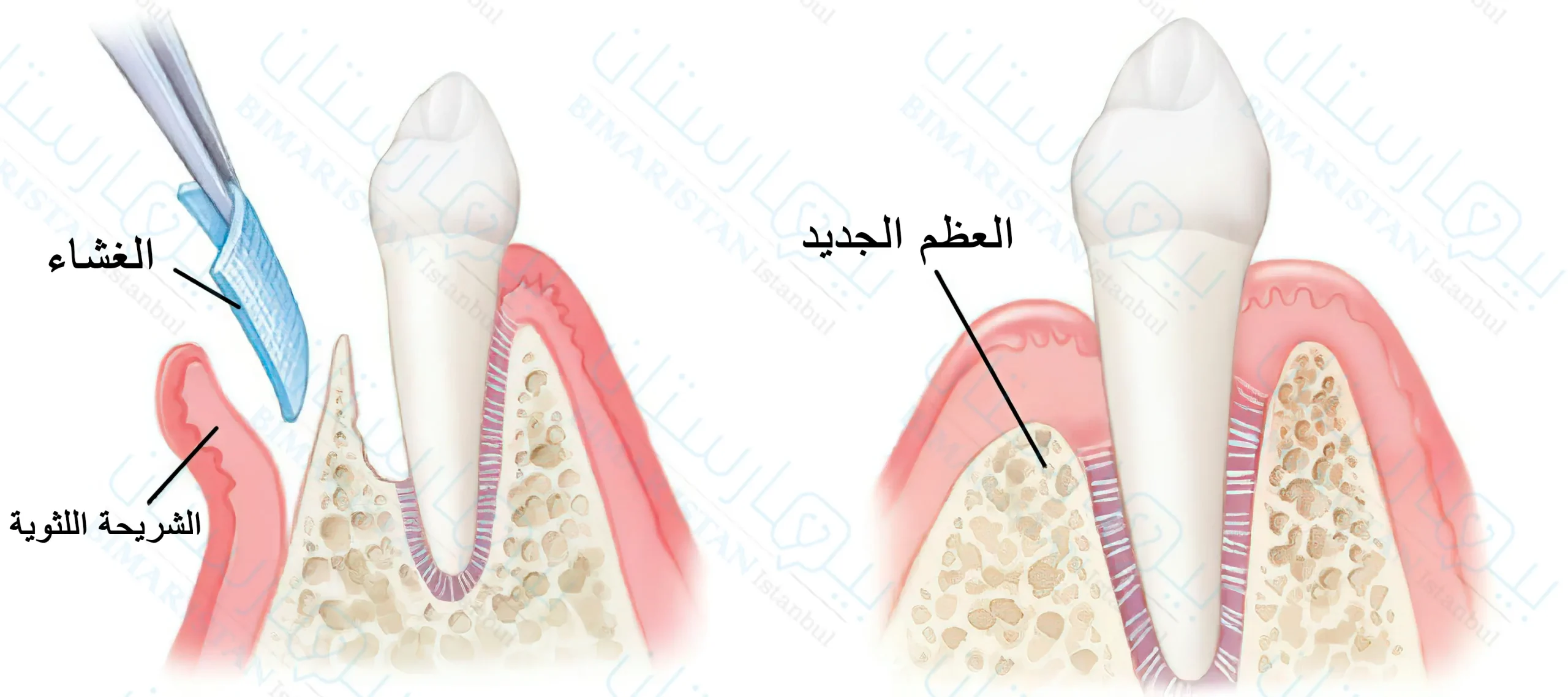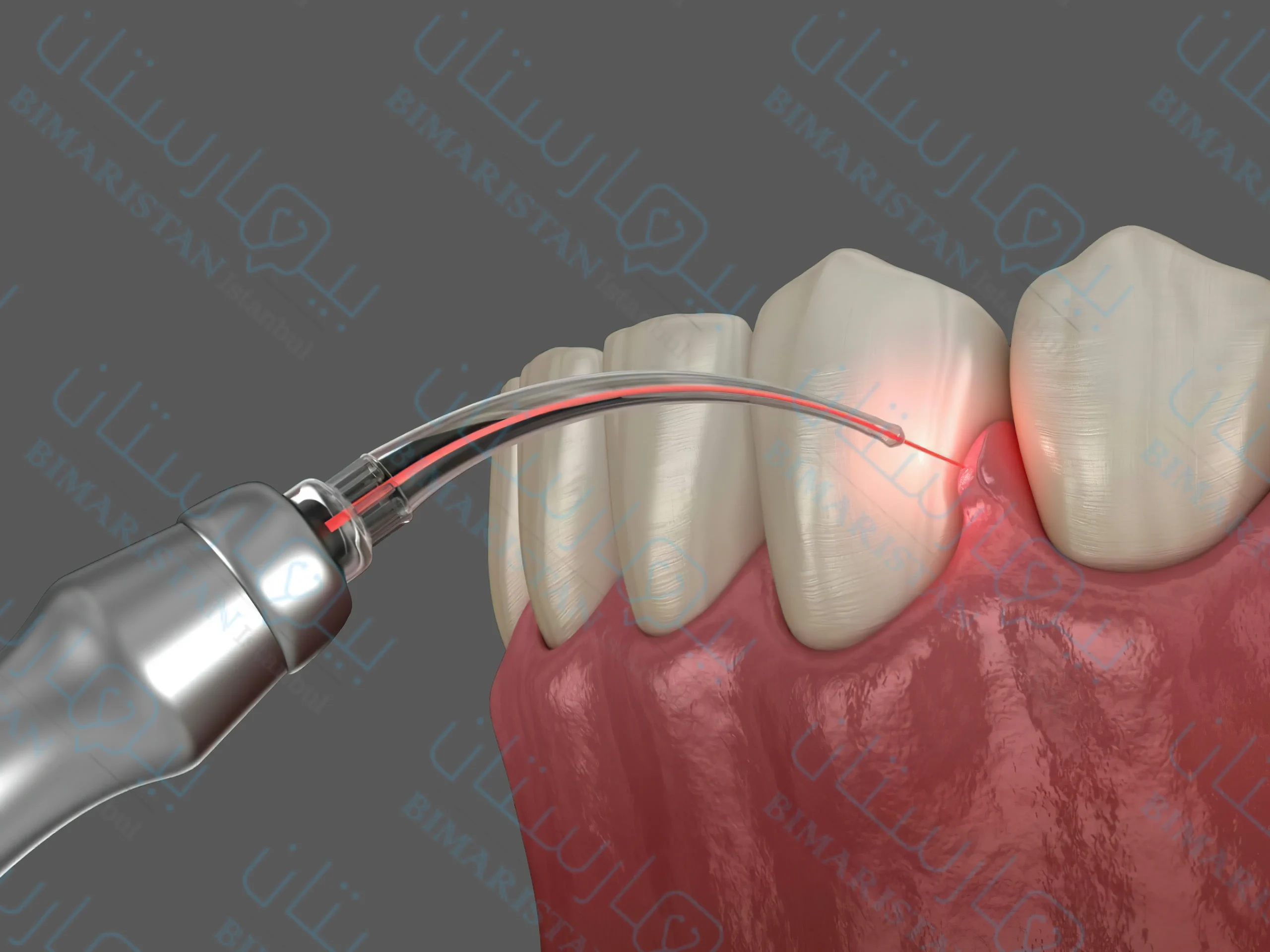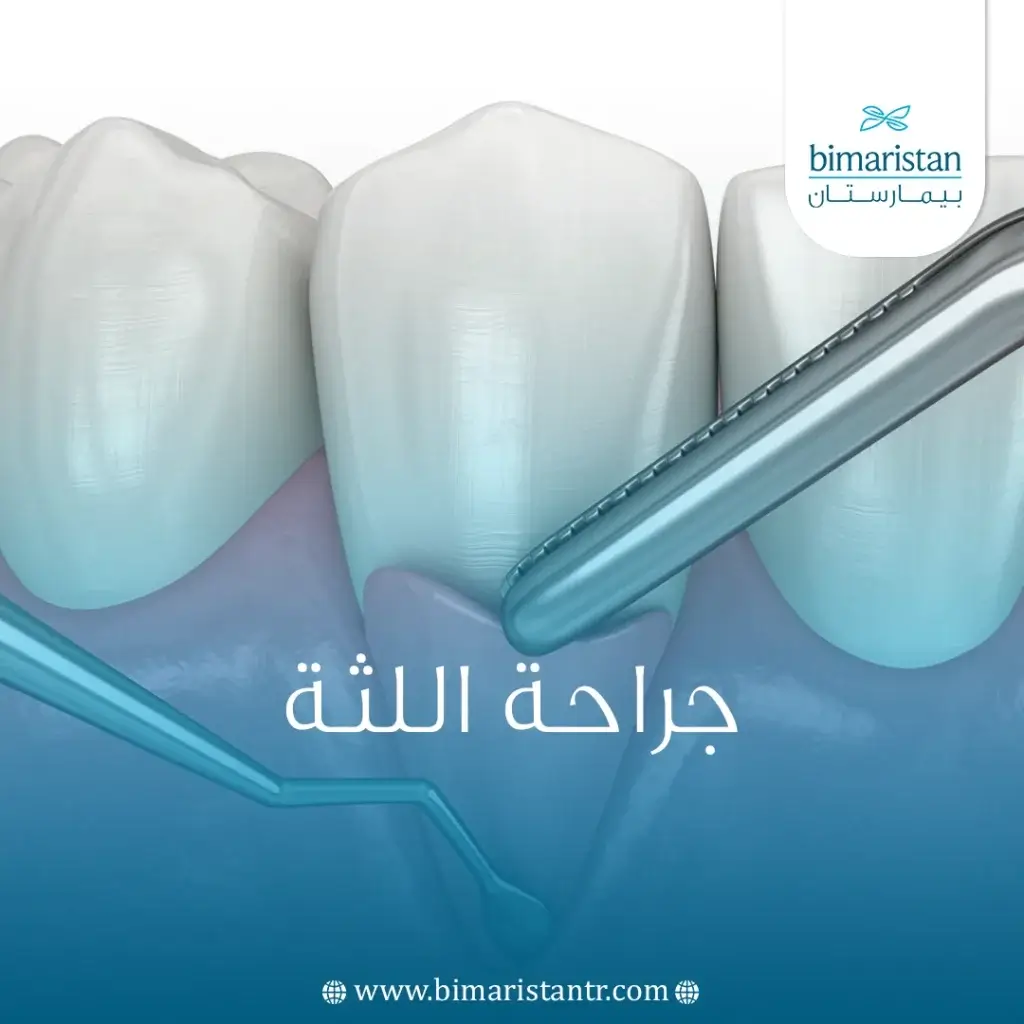جراحة اللثة هي عملية تهدف لعلاج بعض أمراض اللثة وحالاتها مثل التهاب وتراجع اللثة، في هذه المقالة سنتعرف على أنواع جراحات اللثة في تركيا ومراحل عملها.
عندما تتخطى زيارات عيادة طبيب الأسنان لفترة طويلة جداً يمكن أن تتسبب أمراض اللثة غير المعالجة في إصابتك بأمراض اللثة المتقدمة التي تتطلب جراحة ، يُعرف هذا النوع من الجراحات باسم جراحة اللثة وهو يهدف إلى تجميل اللثة وعلاج امراض اللثة وأي ضرر حاصل عن طريق:
- إعادة نمو العظام والأنسجة التالفة
- منع فقدان الأسنان
- تقليل فجوات اللثة بين الأسنان والمعروفة باسم المثلثات السوداء
- إعادة تشكيل عظم الفك لتقليل مخاطر نمو البكتيريا في شقوق العظام
- القضاء على البكتيريا والعدوى

ما هي الحالات التي يمكن أن تعالجها جراحة اللثة؟
قد تتطلب بعض أمراض اللثة مثل التهاب اللثة والتهاب دواعم الاسنان علاجاً جراحياً في إحدى مراحلها كما تتطلب بعض الحالات إجراء عملية تجميل اللثة لتصحيح تموضعها.
التهاب اللثة حول الأسنان هو شكل خفيف من أمراض اللثة تكون فيها اللثة حمراء متورمة ونازفة، يحدث التهاب اللثة في أغلب الأحيان بسبب سوء نظافة الفم وتراكم البلاك والجير.
العلاج الفعال بإشراف الطبيب يمكن أن يعكس الحالة ونحصل على اللثة السليمة.
التهاب دواعم السن أو النسج الداعمة هو شكل أكثر خطورة من أمراض اللثة حيث يتفاقم التهاب اللثة ويتقدم مما يؤدي إلى حدوث استجابة التهابية تدمر العظام والأنسجة.
خلال هذه العملية الالتهابية تبدأ اللثة الملتهبة بالانفصال عن الأسنان مما يتسبب في ظهور فراغات تسمى الجيوب والتي بدورها تحبس البكتيريا وتؤدي إلى الإنتان ونتيجة لذلك يمكن أن يحدث فقدان الأسنان وتلف العظام.
بعض أنواع جراحات اللثة التي تتم في تركيا
يعتمد نوع جراحة الفم واللثة التي يقوم بها جراح الأسنان على نمط وشدة مرض اللثة.
قبل الجراحة قد يقوم جراح الأسنان بتنظيف اللثة بعمق يُعرف هذا الإجراء باسم التقليح العميق الذي يهدف لإزالة الجير والبكتيريا من الأسنان واللثة.
بالإضافة لإجراء آخر يزيل أي جير من الجذور يُعرف باسم التنضير الجذري بهدف تنعيم أسطح جذور الأسنان وتقليل تراكم الجير والبكتيريا، يتم عمل التقليح وتنضير الجذور بالوقت ذاته.
جراحة رفع الشريحة
جراحة اللثة الملتهبة يتم فيها فتح شريحة ظرفية، وهي مفيدة بشكل خاص للأشخاص الذين لديهم ترسبات جير في الجيوب العميقة، يتضمن الإجراء عملية قص اللثة ورفع الغشاء المخاطي اللثوي عن الأسنان لإزالة تراكم الجير.
بعد أن يقوم اخصائي جراحة اللثة بتنظيف المنطقة وإزالة الجير يقوم بخياطة اللثة في مكانها لتتناسب مع الأسنان، في بعض الأحيان قد يتم إعادة تشكيل العظم أثناء هذا الإجراء.

الطعوم العظمية
عندما يحدث تلف أو تدمر العظم المحيط بجذر السن قد يحتاج الشخص إلى وضع طعم عظمي حيث يتضمن هذا الإجراء استبدال العظم التالف بعظم جديد يكون إما من عظام الشخص نفسه أو عظام صنعية أو عظام متبرع بها.
الهدف من وضع الطعوم العظمية هو تثبيت السن في مكانه ومساعدة النسج على النمو من جديد.

تجديد الأنسجة الموجه GTR
في هذا الإجراء يقوم جراح الأسنان بوضع قطعة صغيرة من غشاء يشبه الشبكة بين عظام الشخص وأنسجة اللثة، تمنع هذه المادة اللثة من النمو في الفراغ حيث يجب أن يملؤه العظم مما يسمح للعظم والنسيج الضام بإعادة النمو.

طعوم النسج الرخوة
في بعض حالات تراجع وانحسار اللثة الناتجة عن فقدان أنسجة اللثة قد نحتاج لاستخدام عملية ترقيع وتطعيم للثة أو كما تسمى عملية زراعة اللثة بطعوم من النسج الرخوة لتقليل مخاطر حدوث المزيد من الضرر.
خلال هذا الإجراء يقوم اخصائي أمراض وجراحة اللثة عادةً بإزالة الأنسجة من جزء محدد من الجسم غالباً مايكون من نسيج سقف الفم، ويتم إعادة وضعها كطعم نسيجي في المنطقة التي انحسرت بها اللثة فيغطي تطعيم الأنسجة أي جذور مكشوفة ويقلل من خطر حدوث المزيد من الضرر.
بينت الدراسات أنه لافرق يذكر من الناحية الجمالية بين هذه التقنية وتقنية تجديد الأنسجة الموجه في حال علاج حالة انحسار اللثة.

تقنية جراحة الثقب
التقنية الجراحية ذات الثقب (PST) Pinhole surgical technique هي علاج جديد نسبياً أثبت فعاليته في علاج تراجع اللثة الخفيف إلى المتوسط، وهو إجراء طفيف التوغل يتضمن إحداث ثقب صغير في أنسجة اللثة فوق جذر السن المكشوف ومن ثم إدخال أداة خاصة في الفتحة لفصل اللثة عن السن، بعدها يقوم الطبيب بتمديد اللثة وإعادة وضعها فوق جذر السن المكشوف وتغطيته بالكامل.

تشمل خيارات العلاج الأخرى:
الليزر وجراحة اللثة
على الرغم من عدم وجود دليل حالي يدعم علاج اللثة بالليزر بشكل كامل إلا أن بعض أطباء الأسنان يستخدمونه لتقليل حجم الجيوب واستعادة النسيج الضام التالف.

البروتينات المحفزة للأنسجة
يتضمن هذا الإجراء استخدام مادة هلامية تحتوي على بروتين لتحفيز نمو العظام والأنسجة.
التحضير لعملية جراحة اللثة
قبل أن يخضع الشخص للعملية الجراحية في اللثة يقوم أخصائي الأسنان بإجراء فحص ما قبل الجراحة للتأكد من كون الجراحة آمنة.
خلال هذا الاختبار من المرجح أن يقوم طبيب الأسنان بما يلي:
- إجراء مراجعة للتاريخ الطبي وإجراء تحاليل
- فحص الأسنان والفم والفك للتأكد من ثباتها وصحتها
- التحقق من وجود أي عدوى أو خراجات أو آفات أخرى يمكن أن تجعل الشفاء من الجراحة أكثر تعقيداً
- مناقشة مخاطر وفوائد العملية والحصول على إذن وموافقة للمضي قدماً في الجراحة
ماذا يحدث أثناء جراحة اللثة
يختلف ذلك اعتماداً على نوع الإجراء الجراحي ولكن بشكل عام تستغرق معظم إجراءات جراحة اللثة حوالي ساعتين حتى تكتمل.
في بعض الحالات الجراحة يتطلب إجراؤها أن يكون الشخص تحت التخدير العام بالكامل أثناء العملية وفي حالات أخرى يكتفى فيها باستخدام المخدر الموضعي لتخدير اللثة، يمكن أن يكون حقن الدواء المخدر غير مريح إلى حد ما.
أثناء الجراحة يستخدم جراح الأسنان معدات معقمة بما في ذلك الأدوات والشانات وذلك لتقليل خطر الإصابة بالعدوى.
يتم قص اللثة عن طريق عمل شقوق جراحية صغيرة على طول خط اللثة ومن ثم رفع اللثة بعيداً عن الأسنان مما يسمح للطبيب برؤية الجذور بشكل أفضل حتى يتمكن من إزالة وتنظيف أي جير أو لويحة أو إنتان.
بعد هذا التنظيف العميق يمكن لجراح الأسنان القيام بالإجراءات الأخرى مثل إعادة تشكيل اللثة أو إجراءات تجديد العظام أو غيرها من الإجراءات المخطط لها.
بمجرد اكتمال جراحة الأسنان المخطط لها سيقوم الجراح بخياطة اللثة مرة أخرى في مكانها باستخدام غرز بخيوط دقيقة تتم إزالتها بعد 7 إلى 10 أيام من الجراحة.
التعافي من جراحة اللثة
بعد أي إجراء للأسنان سيقدم طبيب الأسنان تعليمات مفصلة حول كيفية تحقيق أفضل تعافي ممكن، يعتمد طول فترة التعافي على نوعية الإجراء الجراحي الذي تم إنجازه.
عادة، سيحتاج الأشخاص إلى أدوية لتسكين الآلام في الأيام التي تلي جراحة اللثة، سيتحدث طبيب الأسنان مع المريض عن أي عقاقير موصى بها قبل مغادرته العيادة أو المركز الجراحي.
قد يوصي أطباء الأسنان أيضاً بما يلي:
- استخدام غسول فم مطهر للحفاظ على نظافة المنطقة وتجنب العدوى
- تجنب التمارين الشاقة
- تناول الأطعمة اللينة في الأيام التالية للجراحة
- تجنب التدخين
سيحدد طبيب الأسنان موعداً لمراجعة العيادة خلال مدة أسبوع إلى أسبوعين، خلال هذا الموعد سيتحقق الجراح من تعافي اللثة ويزيل أي غرز.
سيرى ويشعر الشخص بلثته مختلفة بعد الجراحة سوف تلتئم اللثة والأسنان متماسكة القوام وتصبح أقوى وأقسى، قد يعاني بعض الأشخاص من حساسية الأسنان لدرجات الحرارة الساخنة أو الباردة وقد يجدون الراحة عند استخدام معجون الأسنان المزيل للحساسية.
مضاعفات جراحة اللثة
مضاعفات جراحة اللثة قليلة وغير شائعة ومع ذلك من الممكن أن يعاني بعض الأشخاص مما يلي:
- نزيف اللثة
- تورم اللثة
- الشعور بتخلخل الأسنان (يجب أن يكون مؤقتاً فقط)
- حساسية الأسنان
- ظهور فراغات بين الأسنان
- الإنتان
في جراحات الطعوم قد لا يتم ربط نسيج الطعم في موقعه بشكل صحيح، هذا نادر جداً ولكن إذا حدث ذلك فقد يحتاج الشخص إلى تكرار إجراء العملية الجراحية.
بعض الناس لا يعجبهم شكل اللثة بعد جراحة تطعيم أو زراعة اللثة، في هذه الحالات قد يتمكن أخصائي اللثة من إعادة تشكيل اللثة للمساعدة في تغيير مظهرها.
تذكر، عليك الحذر!
إذا تُركت أمراض اللثة دون علاج فقد تؤدي إلى تطور مجموعة متنوعة من المشاكل الصحية مثل أمراض القلب والأوعية الدموية والسكري والولادة المبكرة لأطفال منخفضي الوزن.
يمكن أن تصبح أمراض اللثة أيضاً حالة صحية خطيرة تؤثر على الأسنان واللثة والعظام، مما يؤدي إلى العدوى وموت العظام والأنسجة مما قد يتطلب جراحة مكثفة لإصلاح الحالة وعلاجها.
يمكن أن يؤدي تقليل عوامل الخطر والحفاظ على نظافة الفم والحفاظ على المواعيد الروتينية للأسنان إلى تقليل مخاطر الإصابة بأمراض اللثة وشدتها.
المصادر
